Olympus BX46 User manual
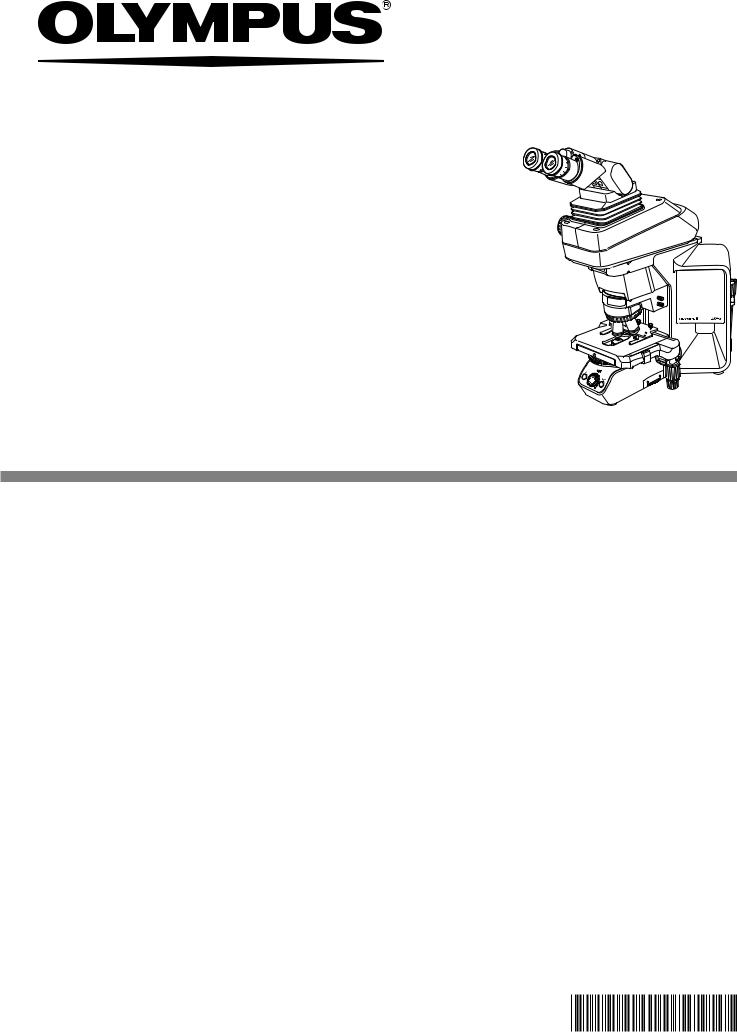
INSTRUCTIONS
BX46
CLINICAL MICROSCOPE
This instruction manual is for the Olympus Clinical Microscope Model BX46.
To ensure the safety, obtain optimum performance and to familiarize yourself fully with the use of this microscope, we recommend that you study this manual thoroughly before operating the microscope.
Retain this instruction manual in an easily accessible place near the work desk for future reference.
A X 7 8 5 3

In accordance with European Directive 2002/96/EC on Waste Electrical and Electronic Equipment, this symbol indicates that the product must not be disposed of as unsorted municipal waste, but should be collected separately.
Refer to your local Olympus distributor in EU for return and/or collection systems available in your country.
NOTE: This equipment has been tested and found to comply with the limits for a Class A digital device, pursuant to Part 15 of the FCC Rules. These limits are designed to provide reasonable protection against harmful interference when the equipment is operated in a commercial environment. This equipment generates, uses, and can radiate radio frequency energy and, if not installed and used in accordance with the instruction manual, may cause harmful interference to radio communications. Operation of this equipment in a residential area is likely to cause harmful interference in which case the user will be required to correct the interference at his own expense.
FCC WARNING: Changes or modifications not expressly approved by the party responsible for compliance could void the user's authority to operate the equipment.

BX46
CONTENTS
Correct assembly and adjustments are critical for the microscope to exhibit its full performance. If you are going to assemble the microscope yourself, please read section 10, “ASSEMBLY" (pages 31 to 34) carefully.
--IMPORTANT -- Be sure to read this section for safe use of the equipment. |
1-3 |
||||||
|
|
|
|
|
|
||
|
|
|
|
|
|
||
1 |
MODULE NOMENCLATURE |
|
|
|
4 |
||
|
|
|
|
|
|
||
2 |
CONTROLS |
|
|
|
5-7 |
||
|
|
|
|
|
|
||
3 |
FLOW OF OBSERVATION |
|
|
|
8,9 |
||
|
|
|
|||||
4 |
SIMPLIFIED OBSERVATION PROCEDURE |
10-12 |
|||||
|
4-1 |
Basic Operation (Until Observation of Specimen)........................................................................ |
10,11 |
||||
|
4-2 |
Microscope Adjustments (How to Improve the Observed Image)......................... |
11,12 |
||||
|
|
1 |
Adjusting the Interpupillary |
11 |
2 |
Adjusting the Diopter.......................................... |
11 |
|
|
|
Distance................................................................................. |
|
|
|
|
|
|
3 |
Adjusting the Centering.................................. |
12 |
4 |
Adjusting the Contrast...................................... |
12 |
|
|
|
|
|
|
||
5 |
USING THE CONTROLS |
|
|
|
13-23 |
||
|
5-1 |
Base................................................................................................................................................................................................................. |
|
|
|
13,14 |
|
|
|
1 |
Adjusting the Brightness................................ |
13 |
2 |
Setting the LIM Brightness.......................... |
13 |
|
|
3 |
Using the Filters.......................................................... |
14 |
|
|
|
|
5-2 |
Focusing Block................................................................................................................................................................................. |
|
|
|
15,16 |
|
|
|
1 |
Focusing Controls................................................... |
15 |
2 |
Adjusting the Focus............................................. |
15 |
|
|
3 |
Replacing the Fine Adjustment |
|
4 |
Adjusting the Coarse Adjustment |
|
|
|
|
Knob............................................................................................ |
16 |
|
Knob Tension.................................................................. |
16 |
|
|
5 |
Pre-focusing Lever.................................................. |
16 |
|
|
|
|
5-3 |
Stage................................................................................................................................................................................................................ |
|
|
|
17,18 |
|
|
|
1 |
Placing the Specimen........................................ |
17 |
2 |
Adjusting the X- and Y-Axis Knob |
|
|
|
|
|
|
|
Tension.................................................................................... |
18 |
|
|
3 |
Rotating the Stage................................................. |
18 |
|
|
|
|
5-4 |
Observation Tube.................................................................................................................................................................... |
|
|
|
19-22 |
|
|
|
1 |
Adjusting the Diopter.......................................... |
19 |
2 |
Using the Eye Shades....................................... |
19 |
|
|
3 |
Mounting the Eyepiece Micrometer |
|
4 |
Selecting the Light Path of the |
|
|
|
|
Disk............................................................................................ |
20 |
|
Trinocular Tube.......................................................... |
20 |
|
|
5 |
Adjusting the Tilt..................................................... |
21 |
6 |
Using Eyepieces Incorporating a |
|
|
|
|
|
|
|
Micrometer...................................................................... |
22 |
|
5-5 Condenser................................................................................................................................................................................................... |
|
|
|
22 |
||
|
5-6 |
Immersion Objectives................................................................................................................................................................. |
|
|
|
23 |
|

6 |
CAMERA RECORDING |
24 |
7 |
TROUBLESHOOTING GUIDE |
25-27 |
8 |
SPECIFICATIONS |
28,29 |
9 |
OPTICAL CHARACTERISTICS (UIS2 Series) |
30 |
10 |
ASSEMBLY -- See this section for the replacement of the light bulb. -- |
31-34 |
11 |
HALOGEN LAMP SOCKET INSPECTION SHEET |
35 |
|
n PROPER SELECTION OF THE POWER SUPPLY CORD.......................................................... |
36,37 |
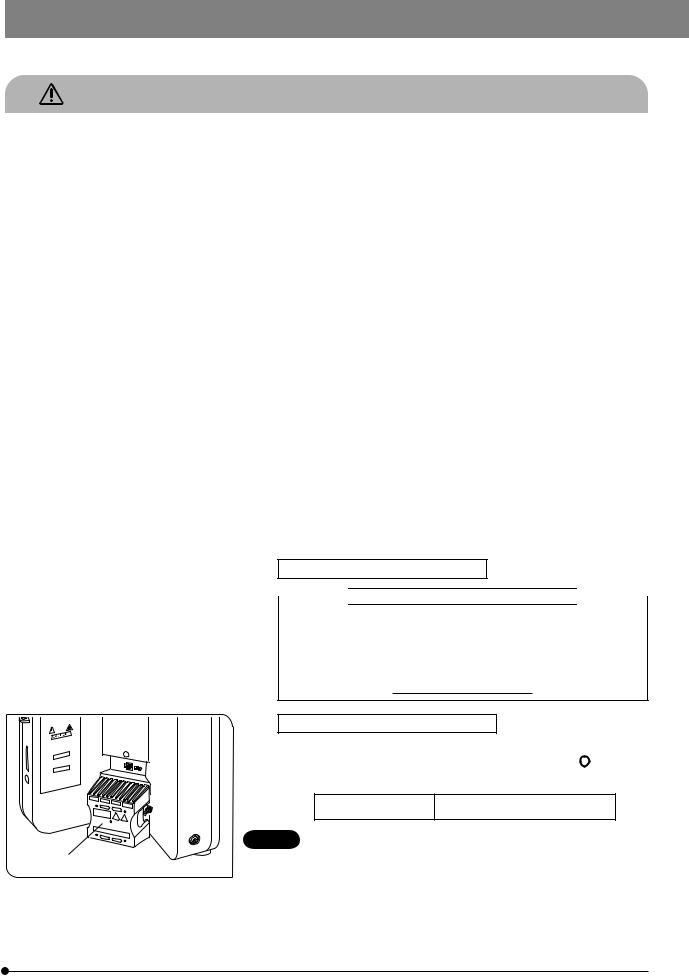
BX46
IMPORTANT
SAFETY PRECAUTIONS |
(Fig. 1) |
1.If potentially infectious samples may be observed, use protective gloves or other protective means to prevent the skin from contacting with samples directly.
After observation, be sure to clean the portion contacted with samples.
áMoving this product is accompanied with the risk of dropping the samples. Be sure to remove the samples before moving this product.
áIn case the samples is damaged by erroneous operation, promptly take the infection prevention measures.
áFollow the procedures described in Chapter ÒGetting ReadyÓ (see on page 2) prior to using the accessories of this product. Otherwise, the stability of the device will be lost and the dropped samples will cause the possibility of infection.
áWhen you maintain the device which may have contacted with potentially infectious reagents, be sure to wear the protectors such as gloves, or clean the device prior to operation.
áBefore disposing of device contacted with potentially infectious samples, be sure to follow the regulations and rules of your local government.
2.Install the microscope on a sturdy, level table or bench.
3.Be careful not to tilt the microscope too much. Otherwise, the mobile parts such as the light path selector knob may move in unintended directions.
4.Always use the power cord provided by Olympus. If no power cord is provided, please select the proper power cord by referring to the section ÒPROPER SELECTION OF THE POWER SUPPLY CORDÓ at the end of this instruction manual.
If the proper power cord is not used, product safety performance cannot be warranted.
5.Always ensure that the grounding terminal of the microscope and that of the wall outlet are properly connected. If the equipment is not grounded, Olympus can no longer warrant the electrical safety performance of the equipment.
Operation Using the LED Lamp
 Safety Note on LED (Light Emitting Diode)
Safety Note on LED (Light Emitting Diode) 
The LED incorporated in the LED lamp housing is a class 1 LED product. The light emitted by LED is basically safe, but do not look at the illumination light directly for an extended period to prevent your eye from being injured
CLASS 1 LED PRODUCT
Operation Using the Halogen Bulb
1. |
To avoid potential shock hazards and burns when replacing the halogen |
|||
|
bulb, set the main switch of the TL4 power supply unit to Ò Ó (OFF) and |
|||
|
allow the lamp socket @ and bulb to cool before touching them. |
|||
|
|
Designated bulb |
6V30WHAL (PHILIPS 5761) |
|
CAUTION |
Always use the designated lamp bulb. Using other bulb may |
|||
cause malfunction. |
|
|||
1 |
|
|
||
If the lamp cable or power cord comes in contact with the lamp socket |
||||
2. |
||||
Fig. 1 |
or its surroundings, the cable or cord may be melted by the heat, causing |
|||
an electric shock or fire hazard. To prevent this, distribute the lamp cable |
||||
|
||||
|
and power cord at enough distances from the lamp socket. |
|||
3. |
The standard service life of the lamp socket is eight (8) years of use or |
|||
|
20,000 hours of total power ON period, whichever is the shorter period. |
|||
|
For details, see Inspection Sheet on page 35. |
|||
1
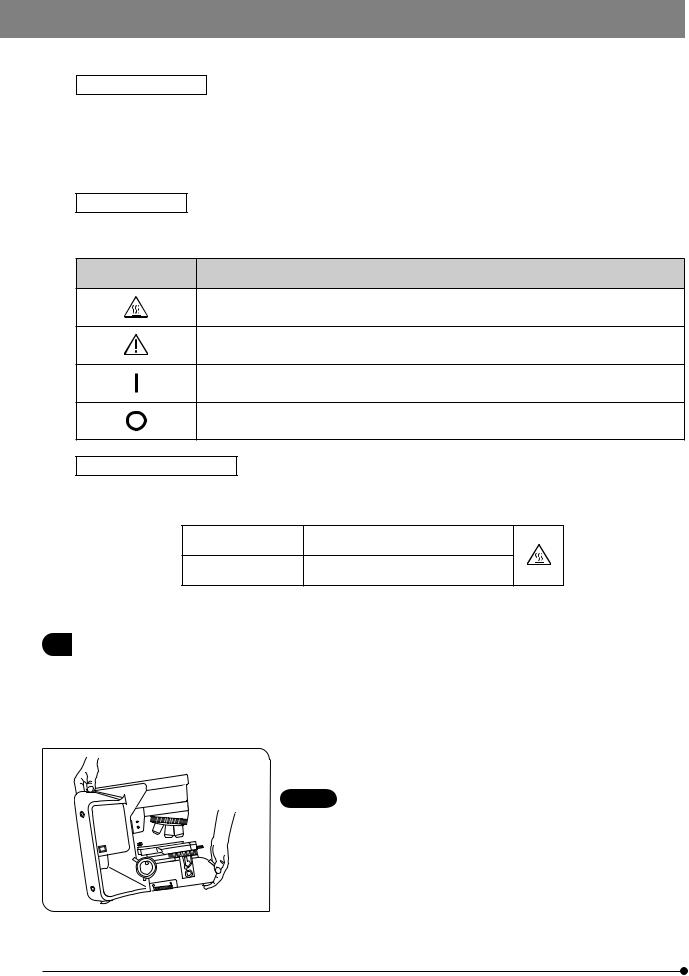
Restrictions in Use
When all combinations (@ to ³) below are satisfied at the same time, the microscope may fall if tilted larger than a certain degree, comparing to other combinations. Please mount the camera port of the intermediate observation tube toward diagonally backward 45¡ to prevent from falling.
@The observation tube is either the trinocular tube, U-TTBI, U-ETBI or U-TTLBI. ²The intermediate observation tube is either U-TRUS or U-DP.
³The camera heavier than 0.4kg is mounted on the intermediate observation tube described in ².
Safety Symbols
The following symbols are found on the microscope. Study the meaning of the symbols and always use the equipment in the safest possible manner.
Symbol |
Explanation |
Indicates that the surface becomes hot, and should not be touched with bare hands.
Indicates a non-specific general hazard. Follow the description given after this symbol or in instruction manual.
Indicates that the main switch is ON.
Indicates that the main switch is OFF.
Caution engraving/label
Caution engraving and label are placed at parts where special precaution is required when handling and using the microscope. Always heed the cautions.
Caution engraving |
Halogen lamp socket |
position |
[Caution against high temperature] |
Caution label |
Rear panel |
position |
[Caution against high temperature] |
If a caution engraving or label is dirty or peeled off, contact Olympus for the replacement or other inquiry.
1 |
Getting Ready |
(Fig. 2) |
1.A microscope is a precision instrument. Handle it with care and avoid subjecting it to sudden or severe impact. Also note that the microscope does not have a waterproof construction.
2.Do not use the microscope where it is subjected to direct sunlight, high temperature and humidity, dust or vibrations. (For the operating conditions, refer to Chapter 8, ÒSPECIFICATIONSÓ.)
3.When moving the microscope, remove the observation and specimen
and carefully carry the microscope by holding the grasping part on the rear of the arm and the front part of the base as shown in Fig. 2.
|
CAUTION |
To prevent damage to the microscope, never hold it by the stage |
|
|
or coarse/fine adjustment knob. |
|
á Even when moving the microscope along the desktop surface, be sure |
|
|
|
to remove the specimen in advance. |
|
á When the microscope needs to be packaged for forwarding to a remote |
|
|
|
location, contact Olympus. |
|
4. When the accessories of this product are used, make sure that the system |
|
|
height does not exceed 1 meter. Otherwise, the stability of the device will |
|
Fig. 2 |
be lost. |
|
5. When an arm, illuminator, intermediate attachment, observation tube and |
||
camera are to be attached to the upper part of the microscope frame, make sure that their total weight does not exceed 7 kg.
2

BX46
2Maintenance and Storage
1.To clean the lenses and other glass components, simply blow dirt away using a commercially available blower and wipe gently using a piece of cleaning paper (or clean gauze).
If a lens is stained with fingerprints or oil smudges, wipe it gauze slightly moistened with commercially available absolute alcohol.
CAUTION · Since the absolute alcohol is highly flammable, it must be handled carefully.
Be sure to keep it away from open flames or potential sources of electrical sparks --- for example, electrical equipment that is being switched on or off, which could cause ignition of a fire.
Also remember to always use it only in a well-ventilated room.
·Set the main switch to “ ” (OFF) and wait for the lamp housing to cool down sufficiently before proceeding to maintenance.
” (OFF) and wait for the lamp housing to cool down sufficiently before proceeding to maintenance.
2.Do not use organic solvents to clean the microscope components other than the glass components. To clean them, use a lint-free, soft cloth slightly moistened with a diluted neutral detergent.
3.Do not disassemble any part of the microscope except for the parts that are specified to be disassembled in this manual, as this could result in malfunction or reduced performance.
4.After using the microscope, set the main switch to “ ” (OFF), (wait for the lamp socket to cool down sufficiently if the halogen bulb has been used,) and keep it covered with a dust cover during storage.
” (OFF), (wait for the lamp socket to cool down sufficiently if the halogen bulb has been used,) and keep it covered with a dust cover during storage.
5.Before disposing of this product, be sure to follow the regulations and rules of your local government.
3 Caution
If the microscope is used in a manner not specified by this manual, the safety of the user may be imperiled. In addition, the equipment may also be damaged. Always use the equipment as outlined in this instruction manual.
The following symbols are used to set off text in this instruction manual.
CAUTION : Indicates a potentially hazardous situation which, if not avoided, may result in minor or moderate injury or damage to the equipment or other property. It may also be used to alert against unsafe practices.
}: Indicates commentary (for ease of operation and maintenance).
4 Intended use
This product has been designed to be used to observe magnified images of specimens in various routine work and research applications.
Do not use this product for any purpose other than its intended use. This product is considered a medical device in the following country: US.
This product complies with the requirements of directive 98/79/EC concerning in vitro diagnostic medical devices. CE marking means the conformity to the directive.
Safety and EMC Precautions
·This product complies with the emission and immunity requirements described in IEC61326 series.
·The electromagnetic environment should be evaluated prior to operation of this product. Do not use this product in close proximity to the sources of strong electromagnetic radiation to prevent interference with the proper operation.
·Use only power cord which OLYMPUS specifies. Otherwise the safety and EMC performance of the product can not be assured.
·Be sure to ground the product. Otherwise our intended electric safety and EMC performance of the product can not be assured.
3
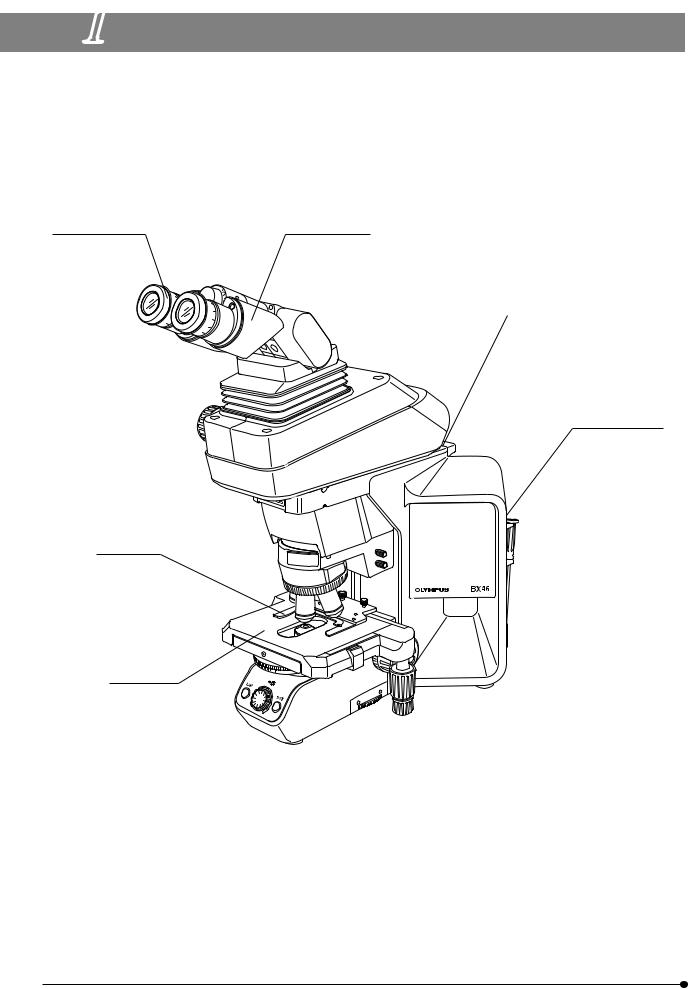
1 MODULE NOMENCLATURE
}The modules mentioned below show only the typical product names. As there are some products that are not mentioned but
also applicable to this microscope, check the latest catalogues or consult Olympus. For the products marked “ * ”, also read their instruction manuals.
Eyepieces |
Observation tube |
· WHN10X |
· U-TTLBI |
· WHN10X-H |
· U-TBI-3 |
|
· U-BI30-2 |
Slide holder
· U-HLST-4 · U-HLS-4
Intermediate attachment
·U-TRU
·U-CA
·U-DO3
Lamp housing
·U-LH100-3
·U-LS30ADP + U-LS30-5 + TL4*
Stage
·U-SVRC
·U-SVRC-CY
4
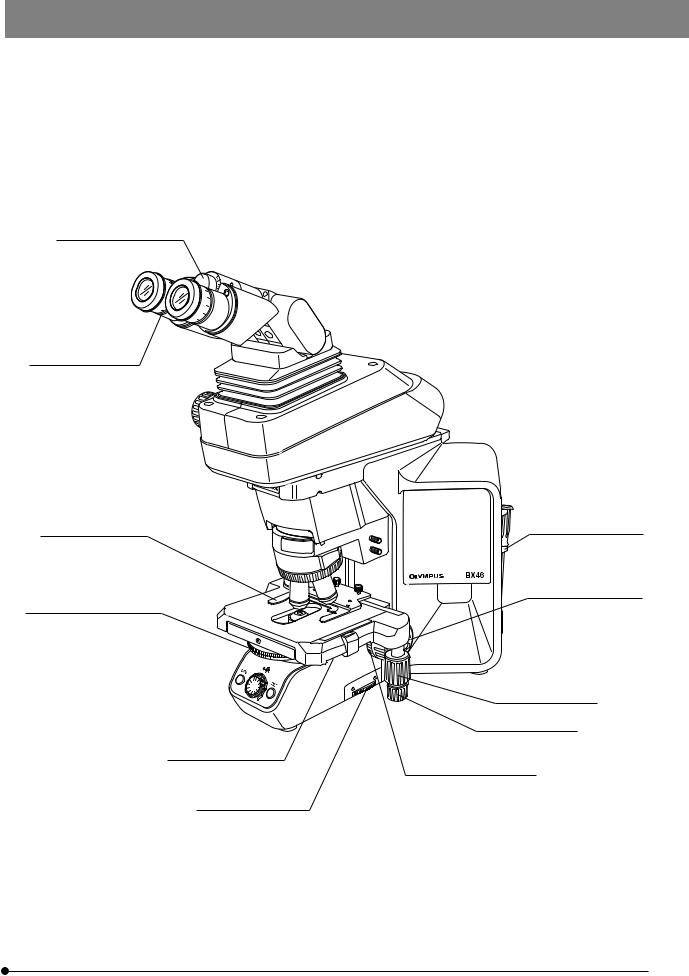
BX46
2 CONTROLS
· If you have not yet assembled the microscope, read section 10, “ASSEMBLY” (pages 31 to 34).
Interpupillary distance adjustment scale (Page 11)
Diopter adjustment ring (Page 19)
Slide holder (Page 17)
Aperture iris diaphragm ring (Page 12)
Filter slider insertion slot
Field iris diaphragm ring (Page 12)
Allen screwdriver holder
Coarse adjustment knob (Page 15)
Y-axis knob (Page 18)
X-axis knob (Page 18)
Coarse adjustment tension adjustment ring (Page 16)
5
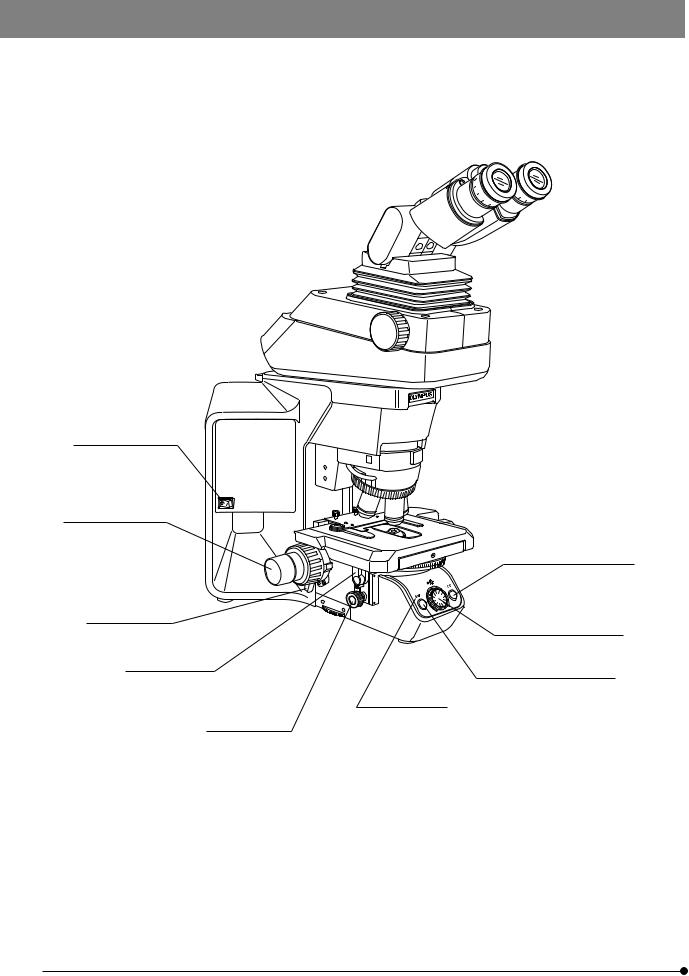
Main switch (Page 10)
I : ON  : OFF
: OFF
Fine adjustment knob (Page 15)
Detachable.
Pre-focusing lever (Page 16)
Top lens swing-out lever (Page 12)
Condenser height adjustment knob (Page 12)
LIM setting switch (Page 13)
LED brightness adjustment knob (Page 13)
LIM ON-OFF switch (Page 13)
LIM indicator
ON : Lit (Green)
OFF : Extinguished
6
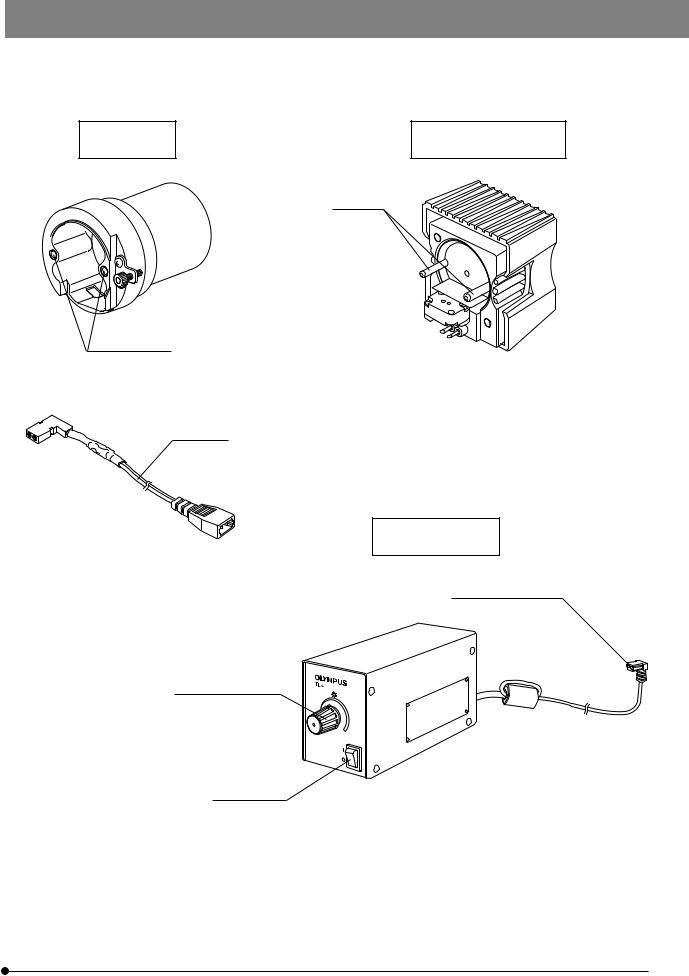
BX46
<< Modules for halogen lamp operation >> |
|
LS30 Adapter |
Halogen Lamp Socket |
U-LS30ADP |
U-LS30-5 |
|
Guide pins |
Guide pin holes
Lamp cable
Power Supply Unit
TL4
Lamp socket connector
Brightness control knob
Main switch
I : ON.  : OFF.
: OFF.
7

3 FLOW OF OBSERVATION
}When the LED lamp is used and the LIM is set, the LED brightness adjustment knob is defeated. }When the halogen bulb is used, set the 32LBD filter in the filter slider and insert it into the insertion slot @.
|
|
|
|
|
|
(Controls Used) |
(Page) |
|||
|
|
|
|
|
|
|
|
|
|
|
|
|
|
|
|
|
LED lamp |
|
Halogen bulb |
|
|
Set the main switch to “ I ” (ON) and adjust |
|
|
@ Main switch |
3 Main switch |
|
|||||
the brightness. |
|
|
2 LED brightness |
4 Brightness |
(P. 13) |
|||||
|
|
|
|
|
|
adjustment knob* |
adjustment knob |
|
||
|
|
|
|
|
|
|
||||
|
|
|
|
|
5 Light path selector knob |
|
||||
|
|
|
|
|
|
|
||||
Select the light path (trinocular tube). |
|
|
|
(P. 20) |
||||||
|
|
|
|
|
|
6 Slide holder |
|
|
(P. 17) |
|
|
|
|
|
|
|
|
|
|||
|
|
|
|
|
|
|
|
|||
Place the specimen on the stage. |
|
|
|
|
|
|||||
|
|
|
7 X-/Y-axis knobs |
(P. 18) |
||||||
|
|
|
|
|
|
|||||
|
|
|
|
|
|
8 Revolving nosepiece |
|
|||
|
|
|
|
|
|
|
||||
Engage the 10X objective in the light path. |
|
|
|
|
||||||
|
|
|
9 Top lens swing-out lever |
(P. 12) |
||||||
|
|
|
|
|
|
|||||
|
|
|
|
|
|
|
||||
|
|
|
|
|
|
|
|
|
|
|
Bring the specimen in focus. |
|
|
|
a Coarse/fine adjustment knobs |
(P. 15) |
|||||
|
|
|
|
|
|
b Binocular tube |
(P. 11) |
|||
|
|
|
|
|
|
|||||
|
|
Adjust the interpupillary distance. |
|
|||||||
|
|
|
c Diopter adjustment ring |
(P. 19) |
||||||
|
|
Adjust the diopter. |
|
d Condenser height adjustment knob |
(P. 12) |
|||||
|
|
|
||||||||
|
|
Adjust the light axis. |
|
e Condenser centering screws |
(P. 12) |
|||||
|
|
|
|
|
|
f Aperture iris diaphragm ring |
(P. 12) |
|||
|
|
|
|
|
|
|||||
|
|
|
|
|
|
|||||
Adjust the aperture iris and field iris diaphragms. |
|
|
|
|||||||
|
|
|
g Field iris diaphragm ring |
(P. 12) |
||||||
|
|
|
|
|
|
|||||
|
|
|
|
|
|
|||||
|
|
|
|
|
|
|
|
|
|
|
Engage the objective to be used in the light |
|
|
|
8 Revolving nosepiece |
|
|||||
path and bring the specimen in focus. |
|
|
|
9 Top lens swing-out lever |
(P. 12) |
|||||
|
|
|
|
|
|
|
|
|
|
|
|
|
|
|
|
|
|
|
|
||
|
|
Engage the required filters. |
|
|
h Filter mount |
|
|
(P. 14) |
||
|
|
|
|
|
|
|||||
|
|
|
|
|
2 LED brightness |
4 Brightness |
(P. 13) |
|||
|
|
|
|
|
||||||
|
|
Adjust the brightness. |
|
|||||||
|
|
|
|
adjustment knob* |
adjustment knob |
(P. 13) |
||||
|
|
|
|
|
|
|||||
|
|
|
|
|
|
|||||
|
|
|
|
|
|
|
|
|
|
|
Start observation.
* The LED brightness adjustment knob is defeated when the LIM is set (see page 13).
8
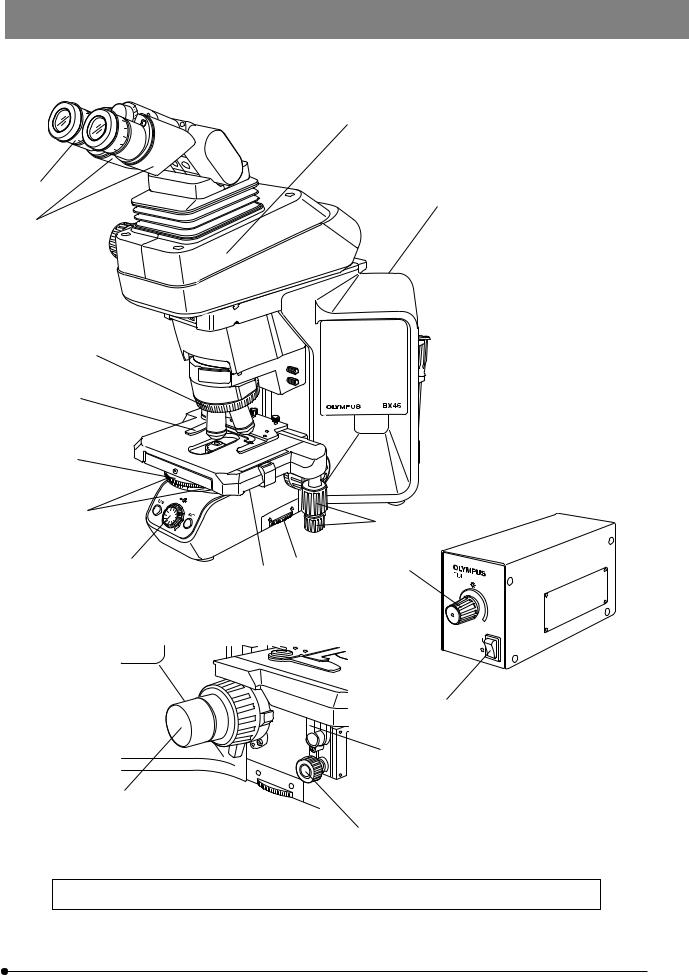
BX46
5 (trinocular tube only)
c
1
b
8
6 |
|
|
f |
|
|
e |
|
7 |
|
|
|
2 |
h g |
4 |
3
9
a
d
} Copy the observation procedure pages on separate sheets and post it near your microscope.
9
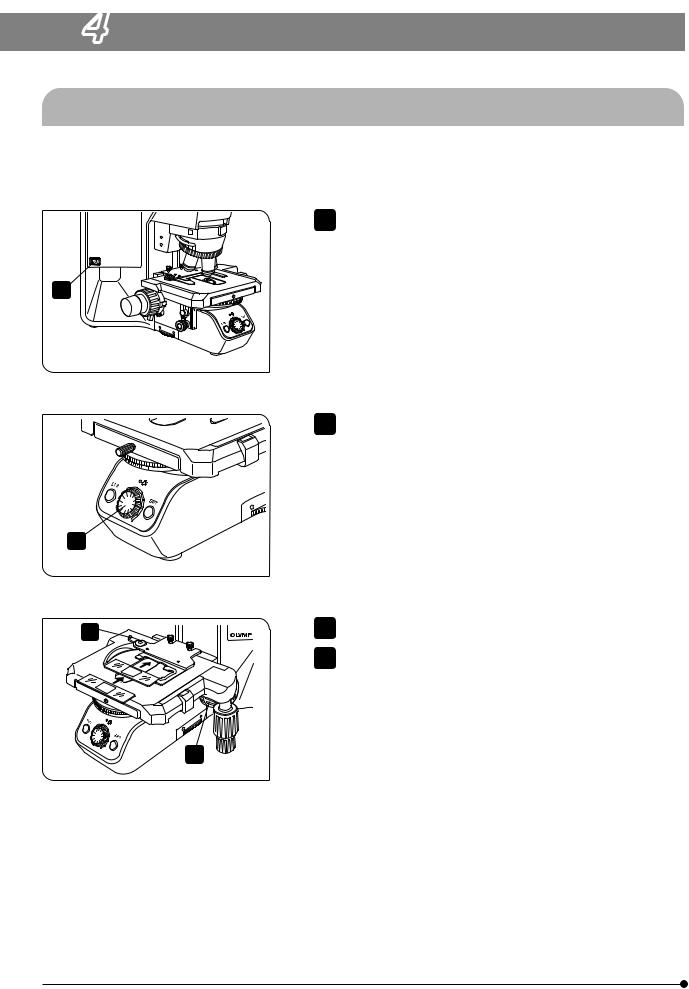
4 SIMPLIFIED OBSERVATION PROCEDURE
4-1 Basic Operation (Until Observation of Specimen)
This section describes the basic operation of the microscope until the start of observation of a specimen. For the detailed operating procedure of each control, please read the description page specified below.
1 Press the main switch of the microscope frame to “ I ” (ON).
1
Fig. 3
2 Rotate the knob to adjust the lamp brightness. (Details: Page 13)
2
Fig. 4
4 |
3 |
|
4 |
Rotate the knob to lower the stage. (Details: Page 16)
Open the clamping lever of the slide holder and place the specimen slide. (Details: Page 17)
3
Fig. 5
10
